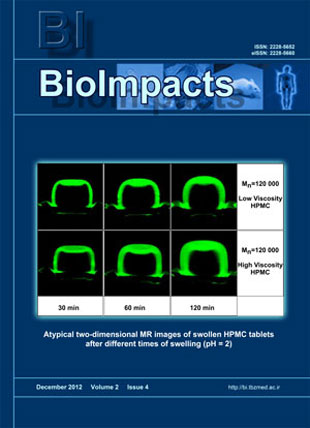فهرست مطالب

Biolmpacts
Volume:2 Issue: 4, Dec 2012
- تاریخ انتشار: 1391/10/05
- تعداد عناوین: 6
-
-
Pages 173-174Mucus in the gastrointestinal tract remains a tenacious barrier that restricts the passage of many orally administered compounds into the GIT’s epithelial layer and consequently into the systemic circulation. This results in significant decreases in the oral bioavailability of many therapeutic molecules. Nanoparticles offer an avenue to surpass this mucus barrier. They can be used as drug carriers to improve the bioavailability of many compounds that are restricted by mucus. Nanoparticles achieve penetration of the mucus barrier through a multitude of properties that they possess as their size, charge density, and surface functional groups which can all be tailored to achieve optimal penetration of the thick and fibrous mucus barrier. This article offers a quick review about the use of nanoparticles as drug carriers to increase mucus penetration in the gastro intestinal tract.
-
Pages 175-187Formulations that are able to control the release of drug have become an integral part of the pharmaceutical industry. In particular oral drug delivery has been the focus of pharmaceutical research for many years. This type of drug delivery has been at the centre of research due to its many benefits over conventional dosage. The focus of this review is on matrix tablets due to their widely use and simplicity of the formulation. This includes the discussion of various types of matrix tablets and factors affecting the drug release from these formulations. The mechanism of drug release from HPMC matrices is also discussed.
-
Pages 189-194IntroductionAlzheimer’s disease (AD) is a common neurodegenerative disorder in elderly people with an impairment of cognitive decline and memory loss. β-amyloid (Aβ) as a potent neurotoxic peptide has a pivotal role in the pathogenesis of AD. This disease begins with impairment in synaptic functions before developing into later neurodegeneration and neuronal loss. The aim of this study was to evaluate the synaptic plasticity and electrophysiological function of granule cells in hippocampal dentate gyrus (DG) after intracerebroventricular (i.c.v.) administration of aggregated Aβ (1-42) peptide in vivo.MethodsAnimals were divided to control and Aβ (1-42) groups. Long-term potentiation (LTP) in perforant path-DG synapses was assessed in order to investigate the effect of aggregated Aβ (1-42) on synaptic plasticity. Field excitatory post-synaptic potential (fEPSP) slope and population spike (PS) amplitude were measured.ResultsAdministration of Aβ (1-42) significantly decreased fEPSP slope and PS amplitude in Aβ (1-42) group comparing with the control group and had no effect on baseline activity of neurons.ConclusionThe present study indicates that administration of aggregated form of Aβ (1-42) into the lateral ventricle effectively inhibits LTP in granular cells of the DG in hippocampus in vivo.
-
Pages 195-205IntroductionAtherosclerosis is a focal disease that susceptibly forms near bifurcations, anastomotic joints, side branches, and curved vessels along the arterial tree. In this study, pulsatile blood flow in a bifurcation model with a non-planar branch is investigated.MethodsWall shear stress (WSS) distributions along generating lines on vessels for different bifurcation angles are calculated during the pulse cycle.ResultsThe WSS at the outer side of the bifurcation plane vanishes especially for higher bifurcation angles but by increasing the bifurcation angle low WSS region squeezes. At the systolic phase there is a high possibility of formation of a separation region at the outer side of bifurcation plane for all the cases. WSS peaks exist on the inner side of bifurcation plane near the entry section of daughter vessels and these peaks drop as bifurcation angle is increased.ConclusionIt was found that non-planarity of the daughter vessel lowers the minimum WSS at the outer side of the bifurcation and increases the maximum WSS at the inner side. So it seems that the formation of atherosclerotic plaques at bifurcation region in direction of non-planar daughter vessel is more risky.
-
Pages 207-212IntroductionABO blood group system is the most important blood group in transfusion and has been widely used in population studies. Several molecular techniques for ABO allele’s detection are widely used for distinguishing various alleles of glycosyl transferase locus on chromosome 9.Methods744 randomly selected samples from Azari donors of East Azerbaijan province (Iran) were examined using well-adjusted multiplex allele- specific PCR ABO genotyping technique.ResultsThe results were consistent for all individuals. The ABO blood group genotype of 744 healthy Azari blood donors was: 25.8% AA/AO (2), 7.6% AO (1), 1.6% BB, 11.3% B0 (1), 10% AB, 9.3% 0(1)0(1) and 15.3%0(1)0(2). The highest genotype frequency belonged to O01/O02 genotype (15.3%) and the lowest frequency belonged to A101/A102 genotype (0.4%).ConclusionsThe frequencies of ABO alleles didn’t show significant differences between East Azerbaijan province population and that of other areas of the country. Meanwhile, statistical analysis of frequencies of A and B alleles between East Azerbaijan province population and neighbor countries showed significant differences whereas the frequency of allele O between them did not show significant difference (P>0.05).
-
Pages 213-215Essentially, people’s diet and nutritional status has been changed substantially worldwide and several lines of evidence suggest that these changes are to the detriment of their health. Additionally, it has been well documented that unhealthy diet especially the fast foods, untraditional foods or bad-eating-habits influence the human gut microbiome. The gut microbiota shapes immune responses during human life and affects his/her metabolomic profiles. Furthermore, many studies highlight the molecular pathways that mediate host and symbiont interactions that regulate proper immune function and prevention of cancer in the body. Intriguingly, if cancer forms in a human body due to the weakness of immune system in detriment of microbiome, the removal of cancer stem cells can be carried out through early Calories Restriction with Annual Fasting (AF) before tumor development or progress. Besides, fasting can balance the gut microbiome for enhancement of immune system against cancer formation.


